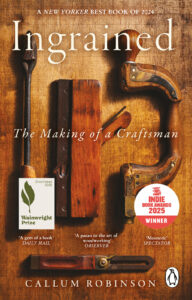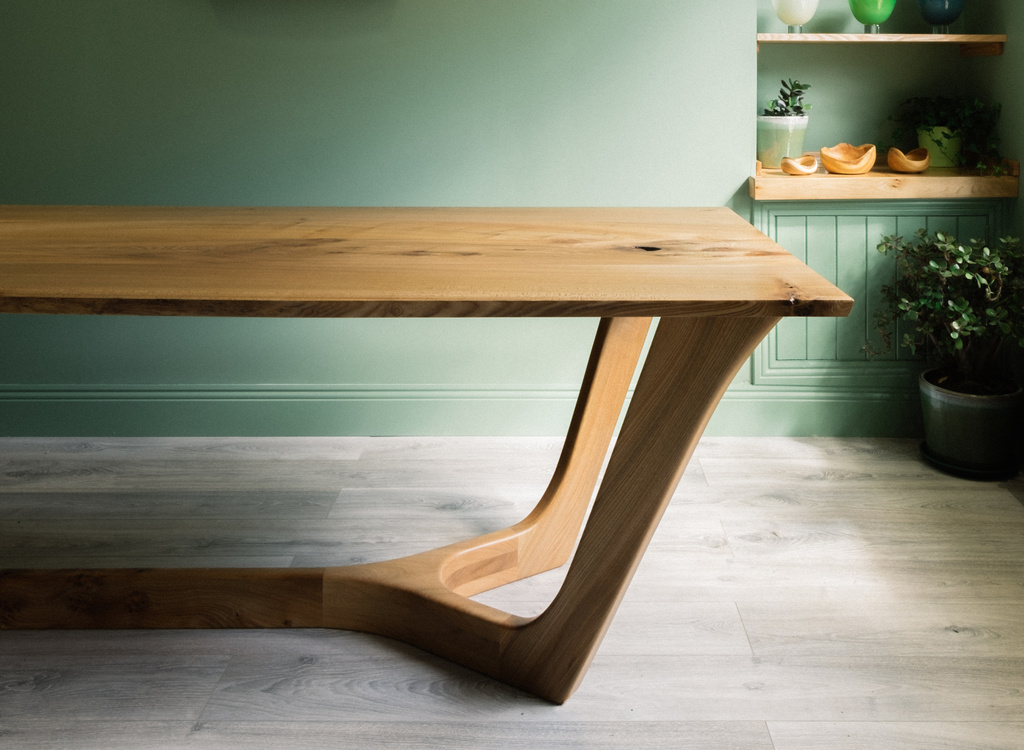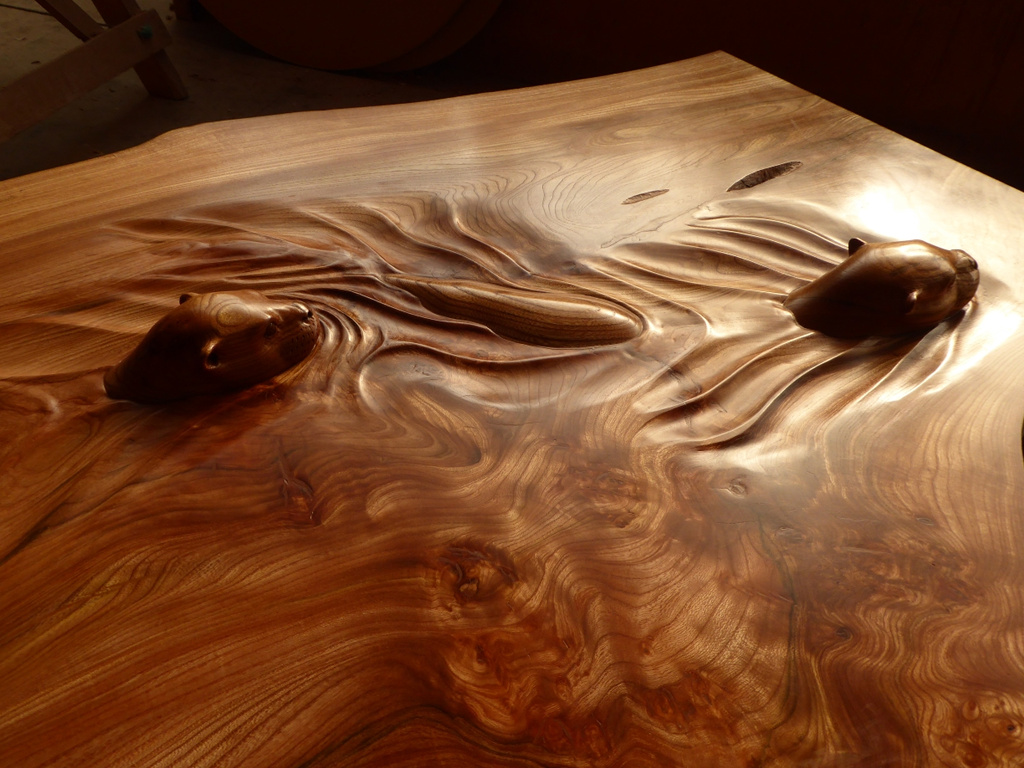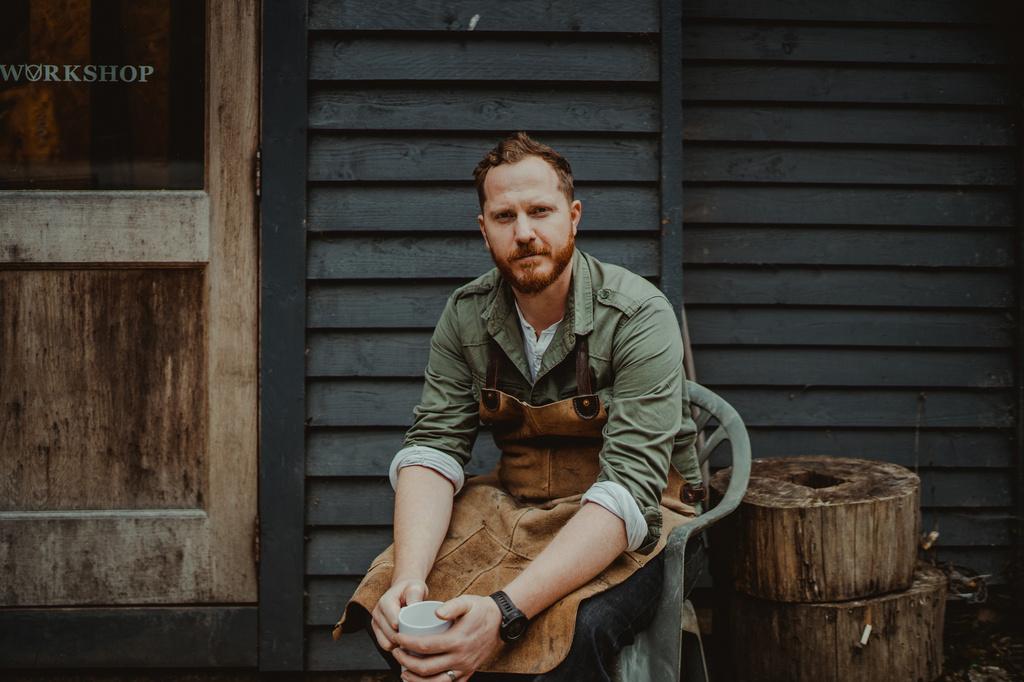- Callum Robinson, Origin Cabinet Blade Edition; Image Graeme Hunter; photo courtesy Method Studio
- Callum Robinson, Origin Table in elm. Image Paul Cowan
- digging through the woodyard 2. Image Benedict Redgrove
- Otter Table by Master Carver David Robinson. Image by David Robinson
D Wood finds a book by a Scottish woodworker that powerfully evokes a well-crafted life.
As I reread Ingrained, I wondered if my background as a woodworker accounted for my appreciating it so much. Certainly, knowing the sights, sounds, smells and feel of woodshops and timber yards meant that the book had resonance; and having spent time in rural settings where old Land Rovers, muddy tracks, and weather-beaten, hard-scrabble characters are the norm, my quotient of empathy was fully engaged.
But, as I went through the book a second time, highlighting descriptions, underlining passages and scribbling in the margins (respectfully in pencil), I acquitted myself of the belief that the audience was limited. After all, Ingrained: The Making of a Craftsman was commended by the Observer, Daily Mail and Financial Times newspapers and was one of The New Yorker’s best books of 2024. You don’t have to wear a plaid shirt and have wood shavings stuck to your overalls to value Callum Robinson’s memoir.
If you read the lines and between them, Ingrained is about every man and woman who has experienced a gut-wrenching end to a seemingly smooth path. It is about making sweet delectable lemonade from lemons and discovering that the after is way better than the before. It is about what it takes to make a commitment to making things by hand and stepping away from the drive for bigger, better and more. It is about sustaining relationships with colleagues, suppliers, clients, family, friends and the natural world in which we dwell. And it is about becoming a craftsperson, but more as a how-to guide than directly applicable to Callum—more on that later.
Dramatis personae
Callum Robinson is a tall, red-haired and -bearded Scot, just like his father. David Robinson was a landscape architect: “hardworking, fastidious and inventive in whatever he did, and tall and broad as a second-row forward”. When the landscaping firm that was his financial lifeline made him redundant, David still had to support a wife, three children and “two ravening collies”, as well as continue to refurbish the “ruinous farmhouse” in which the family lived. At 40 years of age, he applied his hands and skills to making furniture and accessories—oak milking stools, pine blanket box, picture frames, mirrors, doorstops and breadboards—that were shown at a small gallery and led to commissions on which to build a future.
I had felt the rough timber slowly graduate to the texture of polished marble beneath my fingers.
Callum, meanwhile, was a “surly, socially awkward” teenager whose father had the nous to coax his son’s ennui through tasks in the workshop. Exceedingly reluctant at first, Callum applied himself to “fire-branding dozens of slim wooden keyrings” and gradually progressed to being his father’s workmate. When David showed his woodwork in the aforementioned gallery, Callum felt “the warm glow of a little pride blossoming.” But, “It wasn’t my father I was proud of but myself. I had sanded many of those surfaces. I had felt the rough timber slowly graduate to the texture of polished marble beneath my fingers. It was me that had branded those keyrings.” The son grew into his father’s boots, making stuff with his hands.
One review of Ingrained compares it to a novel and, like in a novel, the characters of Callum and David emerge through the narrative rather than appearing in a chronology suited to memoir. For instance, Chapter 1 begins by asking the reader to “picture the biggest tree you’ve ever seen”, and immediately plunges into sensual description: “the air is heavy with the scent of damp leaves and woodsmoke, the loud tick-tick-ticking of the [Land Rover] engine in the early morning mist.” There are people somewhere in this scenario—we hear a chainsaw—and then Ben, the timber yard owner, appears. He’s “between sixty and three hundred years old … sporting chunky logger’s boots, armoured safety trousers suspended by heavy braces and a threadbare flannel shirt so permeated with oil, grime and sawdust it could probably stand up on its own.” Callum and David are here looking for timber. After slabs of elm, six feet across, two inches thick, and two-and-half metres long with “the look of chocolate chip shortbread” are purchased and loaded onto the Land Rover, they retire to the Gleneagles Hotel for a dram or three of whiskey. It is part-way through Chapter 2 that the reader is enlightened as to the conflict of the content.
The other characters of Ingrained are Marisa Giannasi, Callum’s life and work partner, whose Italian heritage ebullience contrasts his Scottish taciturn. She is an architectural designer, part-time teacher of design at Edinburgh College of Art and a whiz at computer-generated drawings. Her practicality and business acumen complement Callum’s craftsmanship. The workshop has three “skilled and energetic craftsmen”: Robin “halfway between a young Mick Jagger and an oil-stained Victorian puffer boat engineer”; Tommy, the fashionista with his Air Jordans, Carhartt pants and Supreme top; and Andrew, a dark-haired Shetlander who, prior to being Callum’s employee, was fired for too much singing—he’s never silent. These men function in a workshop filled with music from Springsteen to hip-hop to Miles Davis’s Kind of Blue. Finally, there is “the dog”, a collie that chases horntails, “huge, striped, wood-boring wasps that make her so unaccountably angry.” Can’t you just picture that?
Plot
The story, like a novel, needs a crisis, although turning point would be a better word. It is a crisis. Having geared up for and counted on a major cabinetry project that would keep the workshop busy for months and eliminate debt, Callum receives a phone call in 2018. The client has cancelled the commission and the prospect of similar work is non-existent. The author believably describes the anxiety and self-recrimination that ensues. Coincidentally this predicament occurs for Callum at about the same age as redundancy for his father.
Like his father, Callum and Marisa resolve the crisis by making it a turning point towards craftsmanship. They rent a small shop in the town of Linlithgow, twenty miles from Edinburgh, and instruct Robin, Tommy and Andrew to make furniture. The men enthusiastically embrace the notion, applying their high standards to such major pieces as an elm dining table, a green leather-topped desk, and oak cabinet, as well as contributing their own ideas. Andrew, adept at the lathe, produces live-edged bowls that, along with cutting boards and platters made from previous jobs’ off-cuts, vary the shop’s prices. David also pitches in by carving a magnificent osprey whose undercut wings stand out from the elm background. Launching this retail outlet is a gamble that not only pays off financially, it consolidates Callum’s role as a maker, instead of a project manager.
The book, as I hope I’ve shown, is packed with description and clever phrasing: he attended “a finishing school for swearing by the foulmouthed roofers”. Callum is a gifted writer, who honed his prose by locking himself in a shed and doing it until he got it right: a follow-up to Ingrained is in the offing. He offers advice in passages titled “A Brief Note On”, covering topics like chairs, finding your voice, marketing or inspiration. He includes history, whether it be the eighteenth-century furnituremaker, Thomas Chippendale, shale oil in Scotland or Glasgow’s renowned designer, Charles Rennie Mackintosh. He owns up to mistakes, elaborates on processes for those unfamiliar with woodcraft, waxes lyrical about trees, makes safety recommendations and betrays a gamut of feelings, not only the negativity that accompanies seeming failure but the joy of observing appreciation for beautiful handcrafted objects. For example, the account of Callum’s relationship with his granny and the love he invested in what he made for her brought me to tears both times I read it.
Denouement
Criticisms: Callum’s mother is missing. I suggest that he would not be the man he is without significant influence from his mother. Perhaps she will be more visible in the second volume. The subtitle: Callum’s craftsmanship was ingrained from, at least, his teenage years. He ingested a craft sensibility in his father’s workshop, took a detour into capitalism, then realized his true nature via an imposed mid-life crisis. I contend that The Making of a Craftsman applies to the reader as in, this is how you become a craftsperson. A better subtitle, applicable to Callum, would be the verification/affirmation/confirmation of a craftsman. To this, the publisher would definitely object.
I could pick many passages worth quoting. I strongly recommend this book as a good read and a bible of craftsmanship. I close with two paragraphs that, to me, prove the book’s must-read quality and confirm the passion with which craft and its makers are empowered.
Having spent journeys in a Land Rover myself, I can only admire Callum’s investment of time and vocabulary to recreate the actuality of being in this iconic vehicle:
“You do not so much drive a Land Rover as launch one – an Alaskan bush pilot cajoling a cranky old floatplane into the sky. Climbing into the cramped cockpit, slamming the tinny door behind you, tapping dials and throwing the sequence of toggle switches just so, turning the huge key and waiting for that muscular diesel to shudder into life. There is the reassuring throaty growl, the exaggerated cabin wobble as you taxi out of the carpark and pick up speed, the almost comically restricted view through the plate glass window, the turbulence … and the noise.”
Finally, as Garland debates the luxury of craft objects and production, Callum weighs in on the constitution of the craft object that makes it worth every penny of the price tag (provoked by the scorn with which a customer viewed the tag):
“forget for a moment the weeks it took to handcraft this fine solid elm table, forget the years of experience brought to bear by the maker, the thousands of hours of training and practice, the costly mistakes, the electricity, insurance and overheads, the team of arborists who brought down the tree, the sawyer who milled and dried the boards, the man in front of you … who painstakingly selected each one before handing over many hundreds of pounds for the privilege, and think on this – this table might last a hundred years, it may last four hundred. Your children’s children might still be sitting around it when you are but a memory.”
Amen and amen.
✿
 Callum Robinson Ingrained: The Making of a Craftsman (London: Penguin Random House, 2025)
Callum Robinson Ingrained: The Making of a Craftsman (London: Penguin Random House, 2025)







